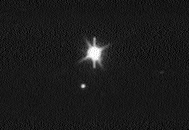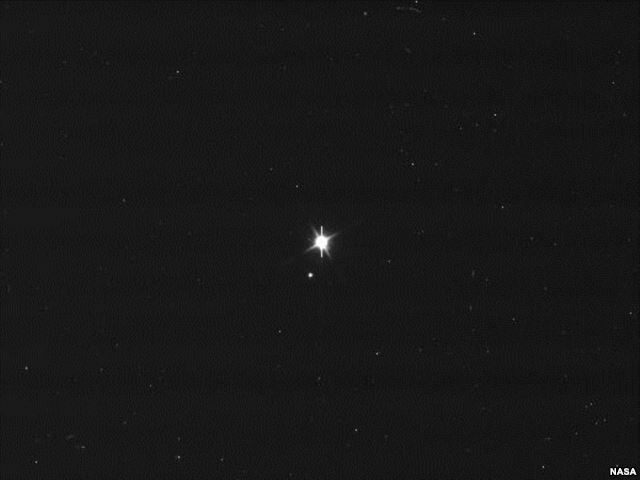SAM / USB:
Internet:


www.rhci-online.net/radiogram/radiogram.htm
██╗ ██╗ ██████╗ █████╗ ██████╗ █████╗ ██████╗ ██╗ ██████╗ ██████╗ ██████╗ █████╗ ███╗ ███╗ ██║ ██║██╔═══██╗██╔══██╗ ██╔══██╗██╔══██╗██╔══██╗██║██╔═══██╗██╔════╝ ██╔══██╗██╔══██╗████╗ ████║ ██║ ██║██║ ██║███████║ ██████╔╝███████║██║ ██║██║██║ ██║██║ ███╗██████╔╝███████║██╔████╔██║ ╚██╗ ██╔╝██║ ██║██╔══██║ ██╔══██╗██╔══██║██║ ██║██║██║ ██║██║ ██║██╔══██╗██╔══██║██║╚██╔╝██║ ╚████╔╝ ╚██████╔╝██║ ██║ ██║ ██║██║ ██║██████╔╝██║╚██████╔╝╚██████╔╝██║ ██║██║ ██║██║ ╚═╝ ██║ ╚═══╝ ╚═════╝ ╚═╝ ╚═╝ ╚═╝ ╚═╝╚═╝ ╚═╝╚═════╝ ╚═╝ ╚═════╝ ╚═════╝ ╚═╝ ╚═╝╚═╝ ╚═╝╚═╝ ╚═╝
RSID: <<2013-07-27T16:02Z MFSK-16 @ 17860000+1500>>
Welcome to program 19 of VOA Radiogram.
Here is the lineup for today's program:
2:22 Program preview (now)
5:01 MFSK16: VOA News re photo of Earth from Cassini spacecraft
:35 MFSK32: Image of Earth and moon from Cassini
3:03 MFSK32: VOA News re dolphins whistling "names"
2:00 MFSK32: Image of dolphins
1:07 MFSK32: Email address and image of logo
6:32 MFSK32/Flmsg: VOA News re solar storm
2:22 MFSK32: Image of coronal mass ejection
1:10 MFSK16: Closing announcements
1:55 MFSK32: Surprise image
Please send reception reports to radiogram@voanews.com
And visit voaradiogram.net
Twitter: @VOA Radiogram
MFSK16 continues...
RSID: <<2013-07-27T16:04Z
MFSK-16 @
17860000+1500>>
Cassini Spacecraft Snaps Photo of Earth from Saturn
VOA News
July 23, 2013
NASA's Cassini spacecraft has captured some rare images of Earth
and its moon as seen from Saturn, about 1.5 billion kilometers
away.
The photos were taken on July 19, with the Earth appearing as a
pale blue dot and the moon a smaller white dot between Saturn's
rings.
"We can't see individual continents or people in this portrait of
Earth, but this pale blue dot is a succinct summary of who we
were on July 19," said Linda Spilker, Cassini project scientist
at NASA's Jet Propulsion Laboratory in Pasadena, Calif.
"Cassini's picture reminds us how tiny our home planet is in the
vastness of space, and also testifies to the ingenuity of the
citizens of this tiny planet to send a robotic spacecraft so far
away from home to study Saturn and take a look-back photo of
Earth," Spilker said.
Pictures of Earth from the outer solar system are rare because
from that distance, Earth appears very close to our sun. A
camera's sensitive detectors can be damaged by looking directly
at the sun, just as a human being can damage his or her retina by
doing the same.
Cassini was able to take the photo because the sun had
temporarily moved behind Saturn from the spacecraft's point of
view and most of the light was blocked.
http://www.voanews.com/content/cassini-captures-image-of-earth-through-saturn-rings/1707545.html
MFSK32 image follows: This image of Earth and the moon was taken
by NASA's Cassini spacecraft on July 19, 2013. Image Credit:
NASA/JPL-Caltech/Space Science Institute...
RSID: <<2013-07-27T16:09Z
MFSK-32
@
17860000+1500>>
Sending Pic:189x130;
|
SAM / USB: |
Internet: |
|
|
|
RSID: <<2013-07-27T16:10Z
MFSK-32
@
17860000+1500>>
Dolphins Use Whistles to Call Each Other by Name
VOA News
July 23, 2013
Dolphins call each other by names, according to a new study.
The study of 200 bottlenose dolphins indicated that they are the
only animals other than humans to use individual names, according
to the research from the Sea Mammal Research Unit at the
University of St. Andrews in Scotland.
In study, co-authors Vincent Janik and Stephanie L. King reported
that dolphins have "signature whistles" they use as greetings
when meeting up. The researchers say individual dolphins have
individual whistles or "names."
The two researchers recorded the whistles of 12 dolphins and
played the whistles back to each dolphin to record their
reactions.
According to the study, in eight of 12 cases, the dolphin replied
when they heard their own whistle. In two cases, the dolphin
responded to the whistle of a dolphin from its own pod--the group
of other dolphins it travels with.
The study said none of the dolphins responded to the sound of a
dolphin it did not know.
"Here, we show that wild bottlenose dolphins respond to hearing a
copy of their own signature whistle by calling back," the
researchers say in their study abstract. "Animals did not respond
to whistles that were not their own signature. This study
provides compelling evidence that a dolphin's learned identity
signal is used as a label when addressing conspecifics.
Bottlenose dolphins therefore appear to be unique as nonhuman
mammals to use learned signals as individually specific labels
for different social companions in their own natural
communication system."
The study, "Bottlenose Dolphins Can Use Learned Vocal Labels to
Address Each Other," was published in Proceedings of the National
Academy of Sciences.
http://www.voanews.com/content/dolphins-whistle-call-by-name/1707815.html
See also:
http://www.pnas.org/content/early/2013/07/17/1304459110.abstract
RSID: <<2013-07-27T16:13Z
MFSK-32
@
17860000+1500>>
Sending Pic:256x144C;
|
SAM / USB: |
Internet: |
|
|
|
RSID: <<2013-07-27T16:15Z
MFSK-32
@
17860000+1500>>
Please send reception reports to
radiogram@voanews.com
And visit voaradiogram.net
Twitter: @VOARadiogram
RSID: <<2013-07-27T16:16Z
MFSK-32
@
17860000+1500>>
Sending Pic:316x28C;
[SAM / USB]
![]()
RSID: <<2013-07-27T16:16Z
MFSK-32
@
17860000+1500>>
Next on VOA Radiogram, a VOA News story in MFSK32 formatted for
Flmsg...
RSID: <<2013-07-27T16:17Z
MFSK-32
@
17860000+1500>>
... start
[WRAP:beg][WRAP:lf][WRAP:fn VOAR19_MFSK32_solar.b2s]<flmsg>1.1.32
:hdr_fm:19
VOA 20132407164505
:hdr_ed:19
VOA 20132407164418
<blankform>
:mg:4119 <h1 style="color:#0000FF;font-style:italic">Voice of America </h1>
<h2 style="color:#FF0000">News / Science & Technology</h2>
<h1>Major Solar Storm Could Be Heading for Earth</h1>
<h3 style="color:#606060">Rosanne Skirble<br>July 22, 2013</h3>
<p>With the sun nearing the peak of its 11-year cycle, scientists say a powerful
solar storm may be headed our way, which could shut down electricity supply
networks and disorient GPS and satellite systems.
<p>The worst known geomagnetic solar storm hit Earth in 1859, observed and
sketched by astronomer <a href="http://www.hao.ucar.edu/education/bios/carrington.php">Richard
Carrington</a>. The Carrington event upset global telegraph communications.
Surprised operators watched sparks fly from telegraph lines and set telegraph
paper on fire.
<p>While not nearly as powerful, other storms in history have cut power, knocked
out telephone service, short-circuited satellites and caused radio blackouts.
<p><b>Major solar storm overdue</b>
<p>The Earth is overdue for another Carrington-like storm, according to a new
report released by <a href="http://www.lloyds.com/news-and-insight/risk-insight/reports/space/space-weather">Lloyd's
of London</a>, the world oldest insurance market.
<p>Co-author <a href="http://www.lloyds.com/news-and-insight/lloyds-blog/our-experts/neil-smith">Neil
Smith</a> says it could be even more devastating, given the worldwide dependence
on electric power supply grids.
<p>"We are estimating that 20-40 million people might be without power from
anywhere up to one, even two years," he said. "That has to do with the critical
issue of replacement transformers. That number of people without power could
result in an
economic cost somewhere between $0.6 trillion to $2.6 trillion."
<p>The focus of the report is North America. Smith says the continent's geologic
features and aging infrastructure put it at high risk for bad solar weather. The
power grid, satellites, aircraft communications, astronauts and oil pipelines
are particula
rly vulnerable. "If there was a big solar flare, it could of course knock out a
whole lot of transformers."
<p>Improved computer models
<p>Michael Wiltberger, a scientist at the <a href="https://www2.hao.ucar.edu/">High
Altitude Observatory</a> of the <a href="http://http//ncar.ucar.edu/">National
Center for Atmospheric Research</a> in Boulder, Colorado, builds models to track
the sun
cycle, ultimately to better predict solar weather.
<p>He observes coronal mass ejections (CMEs) that race through the solar system
at speeds of three million to five million kilometers per hour. They reach Earth
in less than two days. Wiltberger sees them, at the speed of light, less than
eight minutes
after an eruption on the sun.
<p>That gives space weather forecasters some lead time, but Wiltberger says
predicting precisely when and where a storm will hit is much more complex.
<p>"The real challenge that we have, that we are struggling with and trying to
build into our numerical models, is to understand what the magnetic field is
going to be inside this hot gas that is coming out," he said, "because it's that
magnetic field
that is the key that unlocks the entry of energy and mass into the Earth's,
near-Earth's region."
<p>Wiltberger says the models could provide a framework to monitor a storm and
improve predictions. He hopes that system will be operational within five years.
<p><b>Greater international cooperation needed</b>
<p>In the meantime, Neil Smith of Lloyd's of London is calling for greater
cooperation to mitigate the impact before the next big storm comes on the
horizon.
<p>"We are just raising awareness of the issue, because step one is to get
different parties aware that this is a potential issue," he said. "And then we
need to work with governments and the utility industry to tackle it. It's not
something that any
one party could actually solve on their own."
<p>Smith adds that such work is critically important, to avoid what could become
large-scale economic and societal chaos.
<p>http://www.voanews.com/content/major-solar-storm-could-be-heading-for-earth/1706884.html
[WRAP:chksum 5104][WRAP:end]
... end
FLDIGI ====> WRAP ===> C:\Programme\flmsg-1.1.29\flmsg.exe ====> VOAR19_MFSK32_solar.html
Voice of AmericaNews / Science & TechnologyMajor Solar Storm Could Be Heading for EarthRosanne Skirble
|
RSID: <<2013-07-27T16:23Z
MFSK-32
@
17860000+1500>>
MFSK32 image follows with the caption: In a Coronal Mass
Ejection (CME) solar material streaks out through the
interplanetary medium, impacting any planet or spacecraft in its
path. (NOAA)
RSID: <<2013-07-24T16:35Z
MFSK-32
@
17860000+1500>>
Sending Pic:200x176C;
|
SAM / USB: |
Internet: |
|
|
|
RSID: <<2013-07-27T16:25Z
MFSK-16
@
17860000+1500>>
Please send reception reports to
radiogram@voanews.com.
And visit voaradiogram.net.
Twitter: @VOARadiogram
Thanks to colleagues at the Edward R. Murrow shortwave
transmitting station in North Carolina.
I'm Kim Elliott. Please join us for the next VOA Radiogram.
This is VOA, the Voice of America.
RSID: <<2013-07-27T16:26Z
MFSK-16
@
17860000+1500>>
Sending Pic:35x1000C;
![]()
www.rhci-online.net/radiogram/radiogram.htm
http://voaradiogram.net/page/41
VOA Radiogram transmission schedule
(all days and times UTC)
Sat 1600-1630 17860 kHz
Sun 0230-0300 5745 kHz
Sun 1300-1330 6095 kHz
Sun 1930-2000 15670 kHz
All via the Edward R. Murrow transmitting station in North Carolina.
![]()